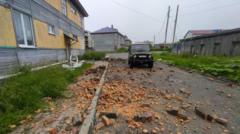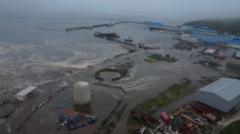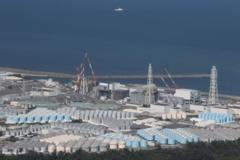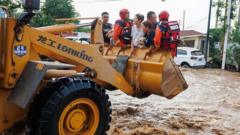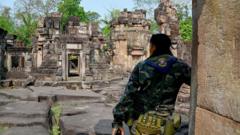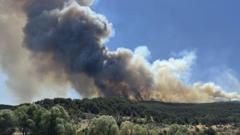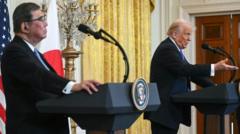In a seismic event that sent shockwaves through the Pacific, a powerful 8.8-magnitude earthquake struck off the coast of Russia's Kamchatka Peninsula at approximately 11:25 local time on Wednesday. The quake triggered tsunami warnings that prompted evacuations for over two million residents across several regions, including parts of Russia, Japan, and Hawaii. Although the earthquake was significant, reports indicate that there were no major injuries or substantial damage in affected areas.
Tsunami Alerts Rescinded Following Massive 8.8-Magnitude Earthquake Near Russia

Tsunami Alerts Rescinded Following Massive 8.8-Magnitude Earthquake Near Russia
Authorities across the Pacific cancel tsunami warnings after a powerful earthquake rocks Russia's Kamchatka Peninsula, sparking widespread evacuations but little reported damage.
As residents evacuated to higher ground in Hawaii following the earthquake, both state and federal emergency officials maintained a cautious approach. Despite the initial threat, waves measuring 1.2 meters on Oahu and 1.7 meters on Maui failed to cause significant harm. Hawaii's Governor Josh Green previously warned residents of the dangers posed by tsunamis but subsequently indicated that the forecasted disaster did not materialize.
The Pacific Tsunami Warning Centre later downgraded the tsunami warning for Hawaii to an advisory, allowing evacuees to return home but advising caution regarding flooding and rising tides. Northern California also registered waves of around 1.09 meters, while the coastal areas of British Columbia, Canada, and other Pacific nations issued warnings and advisories which were later canceled as the threat subsided.
In Russia, where the earthquake originated, tsunami waves reached heights of approximately 5 meters in some areas. Fortunately, initial assessments indicated no major injuries, and the Russian government lifted the tsunami warning shortly thereafter. However, the eruption of the Klyuchevskoy Volcano was reported following the quake, and local officials declared a state of emergency in parts of the Kuril Islands.
Japan, which faced significant evacuations, reported that tsunami warnings were downgraded later in the day. Prime Minister Shigeru Ishiba confirmed no immediate damage to infrastructure, including the Fukushima nuclear plant, where employees were safely evacuated as a precautionary measure.
Meanwhile, multiple Pacific islands and nations, including French Polynesia and parts of South America, were placed on alert status but saw limited impact. The seismic activity underscored the volatility of the Pacific Ring of Fire, a region well-known for high levels of tectonic activity, which is responsible for around 80 percent of the world’s earthquakes.
Overall, despite the magnitude of the quake and its far-reaching impacts, the absence of significant damage or injuries was a relief to residents and authorities alike, emphasizing the importance of preparedness in the face of natural disasters.
The Pacific Tsunami Warning Centre later downgraded the tsunami warning for Hawaii to an advisory, allowing evacuees to return home but advising caution regarding flooding and rising tides. Northern California also registered waves of around 1.09 meters, while the coastal areas of British Columbia, Canada, and other Pacific nations issued warnings and advisories which were later canceled as the threat subsided.
In Russia, where the earthquake originated, tsunami waves reached heights of approximately 5 meters in some areas. Fortunately, initial assessments indicated no major injuries, and the Russian government lifted the tsunami warning shortly thereafter. However, the eruption of the Klyuchevskoy Volcano was reported following the quake, and local officials declared a state of emergency in parts of the Kuril Islands.
Japan, which faced significant evacuations, reported that tsunami warnings were downgraded later in the day. Prime Minister Shigeru Ishiba confirmed no immediate damage to infrastructure, including the Fukushima nuclear plant, where employees were safely evacuated as a precautionary measure.
Meanwhile, multiple Pacific islands and nations, including French Polynesia and parts of South America, were placed on alert status but saw limited impact. The seismic activity underscored the volatility of the Pacific Ring of Fire, a region well-known for high levels of tectonic activity, which is responsible for around 80 percent of the world’s earthquakes.
Overall, despite the magnitude of the quake and its far-reaching impacts, the absence of significant damage or injuries was a relief to residents and authorities alike, emphasizing the importance of preparedness in the face of natural disasters.


